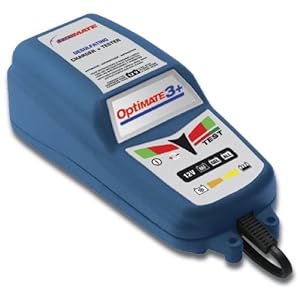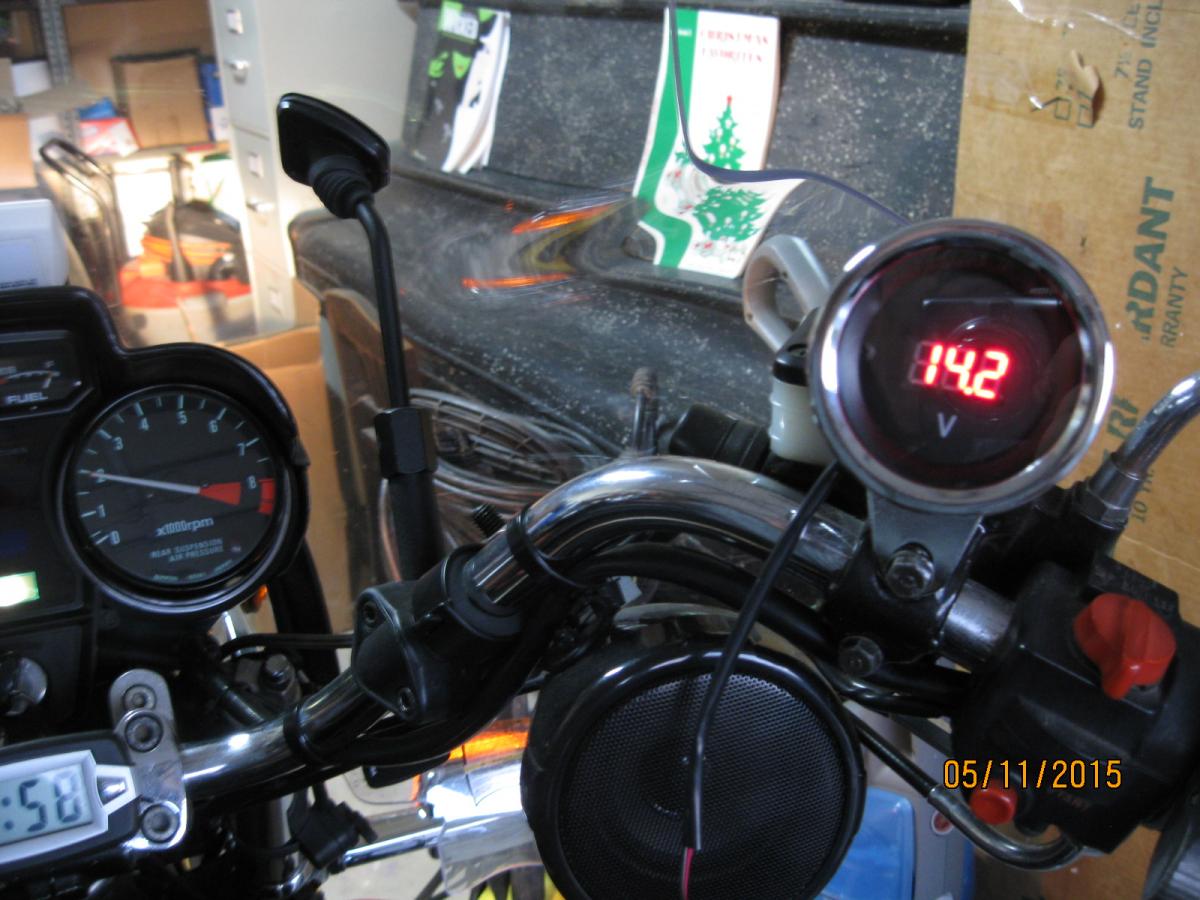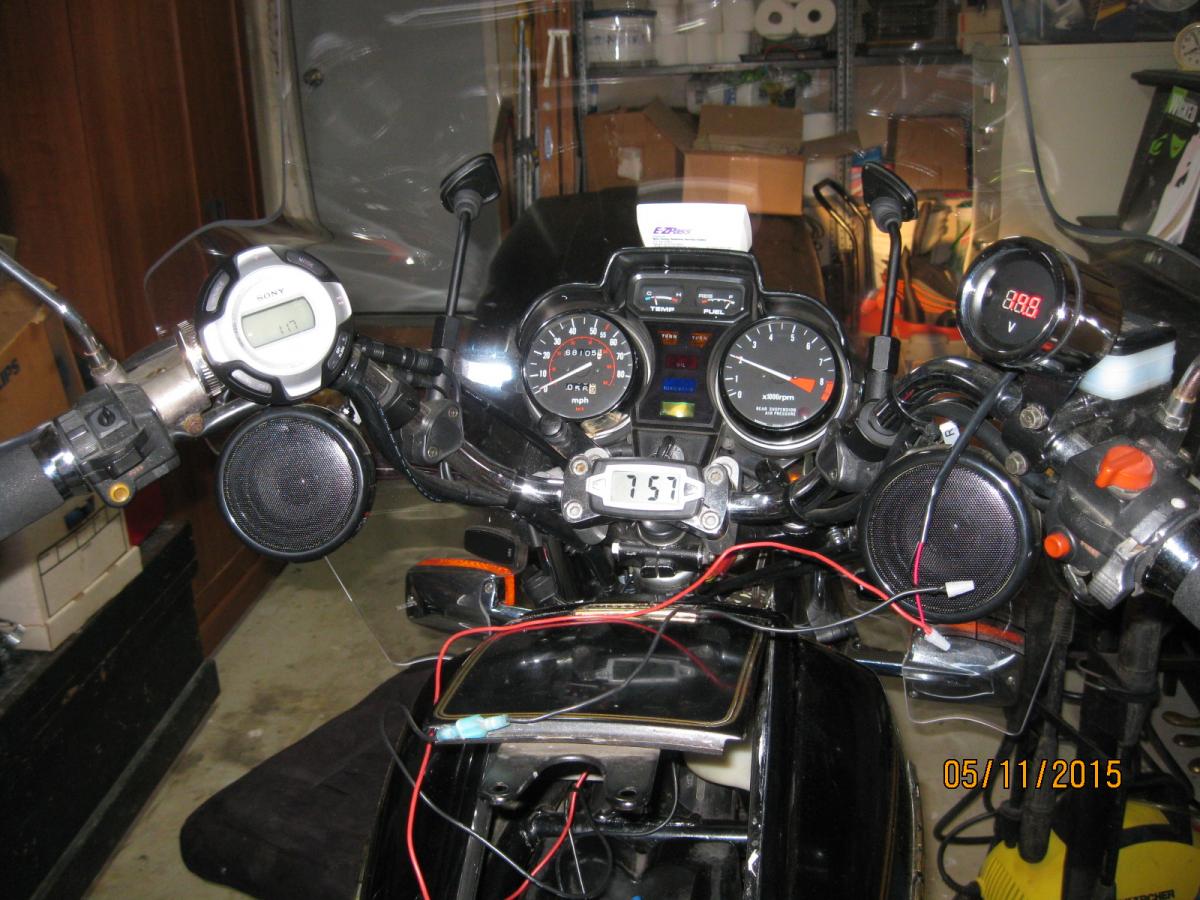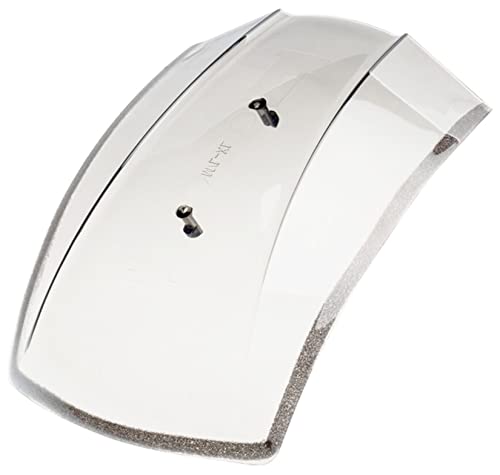Gotta be full metal jacket :smilie_happy: :smilie_happy: :smilie_happy:
You are using an out of date browser. It may not display this or other websites correctly.
You should upgrade or use an alternative browser.
You should upgrade or use an alternative browser.
AGM Battery
- Thread starter mcgovern61
- Start date

Help Support Classic Goldwings:
This site may earn a commission from merchant affiliate
links, including eBay, Amazon, and others.
carl62cycles
Well-known member
got this info online:With Metal Jacket: Provides a slightly higher operating temperature range, slightly more vibration resistance, and protection against debris that may hit the battery (when used in compatible applications)....dan filipi":1hrrhq1i said:Carl, I have the PC680 in mine, close to 2 years now.
It performs fine, has never left me stranded.
Best part of the AGM is no acid drips anywhere.
Odyssey does specify the MJ for our bike. I couldn't see any reason to pay the extra but I wonder if I were to warranty it if they'd honor it.
The answer is, "Yes, it does." Any battery that's not used on a regular basis needs to be attached to a good quality tender. The problem is, most people buy the inexpensive $20 low amp. charger/tenders that, in the long run, destroy a perfectly good battery. The much advertised Battery Tender Plus and Battery Tender Jr. are an example of these types of chargers. Yes, they will keep your battery fully charged and will slowly charge a battery that has been partially drained. But, in the long run, these types of chargers will ruin a good battery as they do nothing to address sulfation.mcgovern61":36gpvjyp said:....I guess my next question is does this battery need a tender over the winter?
If you want to keep you battery on a tender without killing it, buy an intelligent charger like the TecMate TM-151 OptiMate 3+ 0.6Amp Desulfating Charger/Maintainer. This charger has a built-in microprocessor that constantly tests and conditions your battery while keeping it at maximum charge.

- Joined
- Dec 3, 2009
- Messages
- 11,041
- Reaction score
- 308
- Location
- Kingsport, Tennessee
- My Bike Models
- Former '82 GL1100 "The Slug"
It has been a little more than 5 years on this battery and I made a major error! :shock:
I had run the bike, shut it off but left the key in the ACC position overnight and drained the battery flat dead. :head bang:
Put a charger on it and after 10 minutes...nothing. Hook up to my car battery and try a jump (car off), still not enough. Started the car and after 5 minutes the bike finally started. I was watching my digital volt meter the whole time. Engine running and I am only getting 11.2 volts with a max at 11.8 volts. I figure, take the running bike out and it will re-charge the battery. :moped:
Wrong-o. I notice while riding, the volts are never higher than 11.8 even after riding 20 minutes on the highway. I decided to cut the trip short and head back home. Once safely in the garage, I put my volt/ohm meter on to verify the voltmeter is working correctly. The voltmeter is correct! :evil:
Shut down and put a charger on for 4 hours on 2 amps. Voltage still stuck at 11.6. I start the bike again (slow start) and run it in the garage at 2k RPM where the voltage would normally run 14.2. It only got up to 12.2 max. Check the stator plug and it is fine, but both sides of the stator wires are running pretty darn warm. No melting, but I think if I kept trying I could melt them thar wires. :hihihi:
I am pretty sure I killed the battery. I am going to let it rest overnight and try to charge tomorrow. I guess the other lesson learned, dead battery, jump or push start, but the stator may not be able to recover a dead battery.
I had run the bike, shut it off but left the key in the ACC position overnight and drained the battery flat dead. :head bang:
Put a charger on it and after 10 minutes...nothing. Hook up to my car battery and try a jump (car off), still not enough. Started the car and after 5 minutes the bike finally started. I was watching my digital volt meter the whole time. Engine running and I am only getting 11.2 volts with a max at 11.8 volts. I figure, take the running bike out and it will re-charge the battery. :moped:
Wrong-o. I notice while riding, the volts are never higher than 11.8 even after riding 20 minutes on the highway. I decided to cut the trip short and head back home. Once safely in the garage, I put my volt/ohm meter on to verify the voltmeter is working correctly. The voltmeter is correct! :evil:
Shut down and put a charger on for 4 hours on 2 amps. Voltage still stuck at 11.6. I start the bike again (slow start) and run it in the garage at 2k RPM where the voltage would normally run 14.2. It only got up to 12.2 max. Check the stator plug and it is fine, but both sides of the stator wires are running pretty darn warm. No melting, but I think if I kept trying I could melt them thar wires. :hihihi:
I am pretty sure I killed the battery. I am going to let it rest overnight and try to charge tomorrow. I guess the other lesson learned, dead battery, jump or push start, but the stator may not be able to recover a dead battery.
5yrs is long time ...you did well with it
- Joined
- Dec 3, 2009
- Messages
- 22,462
- Reaction score
- 275
- Location
- Van Nuys Ca.
- My Bike Models
- 1983 Interstate
2018 KLR 650
2018 BMW S1000 RR
- My Bike Logs forum link
- https://classicgoldwings.com/forums/dan-filipi.122/
Stator was working fine before the dead battery so I'd guess there's some shorting going on in the battery making it read low.
AGM can stand a higher charge rate than conventional wet cell batteries. I'd google your battery for what that is and for how long.
AGM can stand a higher charge rate than conventional wet cell batteries. I'd google your battery for what that is and for how long.

$100.00
$169.99
1988 Honda Gold Wing GOLDWING GL1500 Service Shop Repair Manual OEM FACTORY 88
GLAVIS ENTERPRISES

$76.00
Honda GL 1800 Gold Wing 2001-2010 Repair Manual (Haynes Service & Repair Manual)
Clickgoodwill

$41.81
$54.95
Clymer Honda GL1200, 1984-1987: Maintenance, Troubleshooting, Repair (Clymer Motorcycle)
Haynes Repair Manuals

$129.00
Sena 30K / 20S / EVO Helmet Clamp Kit for Honda Goldwing CB Helmet Accessories
ProRidersClub

$50.07
M506-2 1993-2000 Honda GL1500 Goldwing Clymer Motorcycle Repair Manual
Classic Automotive Repair Shop & Restoration Manuals

$35.37
$45.95
Show Chrome Accessories 52-696 Honda Goldwing GL1800 01-10 Radio Panel
Amazon.com

$5.33
$6.49
Pink Balaclava Ski Mask Head Mask Full Face Mask Windproof Sun UV Protection Hood for Women Men
Ligart

$9.95
$14.95
BELL Vortex Hinge Plate Kit Street Motorcycle Helmet Accessories - Black/One Size
Movatik

$32.09
$59.95
Honda GL1800 Gold Wing 1800 (01-10) Haynes Repair Manual (Paperback)
Haynes Repair Manuals

$150.00
1984 Honda Gold Wing GL1200 Factory Service Manual Dealer GoldWing Shop Repair Workshop
GLAVIS ENTERPRISES

$48.99
$55.00
HONDA GL1000 & GL1100 GOLDWING MOTORCYCLE REPAIR SHOP & SERVICE MANUAL For 1975, 1976, 1977, 1978, 1979, 1980, 1981, 1982, 1983, 1984 & 1985 - NEW, 304 Pages
Classic Automotive Repair Shop & Restoration Manuals
- Joined
- Dec 3, 2009
- Messages
- 11,041
- Reaction score
- 308
- Location
- Kingsport, Tennessee
- My Bike Models
- Former '82 GL1100 "The Slug"
Google I did and apparently a fully discharged AGM needs more than just a normal charging to come back to life. If the AGM drops below 10.2 volts, apparently chargers will automatically turn off rather than charge. There are two methods recommended for bringing it back to life:
1. take another battery and connect in parallel. Connect a normal charger to it at 10 amps for at least 1 hour. Connecting the batteries allows the charger to see the voltage of the higher battery and allow the amps to flow. Once the AGM reaches at least 11 volts, remove the second battery and use a regular automatic charger at 10 amps for a minimum 5 hours or overnight.
2. Use a AGM smart charger that has a desulfation mode. This type of charger recognizes the depleted battery and slowly corrects the issue. Problem is, these chargers average $100 or more and the new AGM battery is only $102. :smilie_happy:
I am going with door number 1 and give it a shot. :yes:
1. take another battery and connect in parallel. Connect a normal charger to it at 10 amps for at least 1 hour. Connecting the batteries allows the charger to see the voltage of the higher battery and allow the amps to flow. Once the AGM reaches at least 11 volts, remove the second battery and use a regular automatic charger at 10 amps for a minimum 5 hours or overnight.
2. Use a AGM smart charger that has a desulfation mode. This type of charger recognizes the depleted battery and slowly corrects the issue. Problem is, these chargers average $100 or more and the new AGM battery is only $102. :smilie_happy:
I am going with door number 1 and give it a shot. :yes:
- Joined
- Jan 27, 2013
- Messages
- 9,855
- Reaction score
- 34
- Location
- Brisbane Australia
- My Bike Models
- 1981 GL1100 “Rats Nest”
1998 GL1500c Val
1987 CBR1000f “The Pig”
1991 CBR1000f Red
I only use smart chargers that have a recovery mode but even that couldn't rebuild the Rats Nests battery.
- Joined
- Dec 3, 2009
- Messages
- 22,462
- Reaction score
- 275
- Location
- Van Nuys Ca.
- My Bike Models
- 1983 Interstate
2018 KLR 650
2018 BMW S1000 RR
- My Bike Logs forum link
- https://classicgoldwings.com/forums/dan-filipi.122/
I tried method 1 on a agm that read just 7 volts and didn't work but yours reading higher may be hope.
my odyssey pc 680 is still holding up, been on the 1500 wing since 2008. I left the key in the acc position a few months ago and put the 2/10/50 battery charger on 10a and left it until the next morning and it was fully charged. I didn't think that my battery tender 3a charger would get the job done seeing that odyssey batterys want 6a when charging
I killed a PC680 the same way and no kind of charging would bring it back. This in spite of conventional wisdom which suggests that AGM units more readily tolerate full discharges. But, mine was also about 5 years old when I did it. Maybe as they age, they're less hardy?
I thought recently I'd killed the one in the Valkyrie. Bummed out, I was preparing to buy another - only to find TWO very loose battery connections! :roll:
I will never go back to standard lead acid technology. I use the Odyssey in all my machines. As noted in this excellent thread, they do pull ( and expect ) more current during charging.
I thought recently I'd killed the one in the Valkyrie. Bummed out, I was preparing to buy another - only to find TWO very loose battery connections! :roll:
I will never go back to standard lead acid technology. I use the Odyssey in all my machines. As noted in this excellent thread, they do pull ( and expect ) more current during charging.
- Joined
- Dec 3, 2009
- Messages
- 11,041
- Reaction score
- 308
- Location
- Kingsport, Tennessee
- My Bike Models
- Former '82 GL1100 "The Slug"
SUCCESS!! :yahoo:
Door #1 was the way to go (connecting the battery to another good battery and charge for 5 hours). My charger is a small standard charger with a maximum 6 amp output. But, that was enough to do it. Before charging, I had a resting voltage of 11.2 volts at the battery checking with my multi meter. Setup and charged for 1 hour and the meter got up to 13 volts. Let the battery rest and then charged for 5 hours at 6 amps. Let the battery rest again and after 1 hour the resting voltage was 12.7 volts.
Start the bike up and she starts right up. Watch my digital voltmeter on the bike (BTW, which is reading voltage at the ACC terminals of the fuse box, not at the battery) and the voltage gets up to 14.6 at 3k rpm and settles at 12.8-13.1 at idle.
Looks like everything is working like it is supposed to. :yes:
My opinion, having that digital voltmeter is a great addition to the bike. It really does keep me informed about the condition of the electrical system. If I had no voltmeter, I may very well have kept riding just because it appears everything was working after the initial jump start. I would bet money the new stator connector would have heated up as hot as those wires were getting trying to recharge the battery.
Older pics right after I installed the meter:


Door #1 was the way to go (connecting the battery to another good battery and charge for 5 hours). My charger is a small standard charger with a maximum 6 amp output. But, that was enough to do it. Before charging, I had a resting voltage of 11.2 volts at the battery checking with my multi meter. Setup and charged for 1 hour and the meter got up to 13 volts. Let the battery rest and then charged for 5 hours at 6 amps. Let the battery rest again and after 1 hour the resting voltage was 12.7 volts.
Start the bike up and she starts right up. Watch my digital voltmeter on the bike (BTW, which is reading voltage at the ACC terminals of the fuse box, not at the battery) and the voltage gets up to 14.6 at 3k rpm and settles at 12.8-13.1 at idle.
Looks like everything is working like it is supposed to. :yes:
My opinion, having that digital voltmeter is a great addition to the bike. It really does keep me informed about the condition of the electrical system. If I had no voltmeter, I may very well have kept riding just because it appears everything was working after the initial jump start. I would bet money the new stator connector would have heated up as hot as those wires were getting trying to recharge the battery.
Older pics right after I installed the meter:
- Joined
- Jan 27, 2013
- Messages
- 9,855
- Reaction score
- 34
- Location
- Brisbane Australia
- My Bike Models
- 1981 GL1100 “Rats Nest”
1998 GL1500c Val
1987 CBR1000f “The Pig”
1991 CBR1000f Red
:good:
[url=https://classicgoldwings.com/forum/viewtopic.php?p=183121#p183121:1oi6fyw5 said:desertrefugee » Mon Oct 31, 2016 5:34 am[/url]":1oi6fyw5]
I will never go back to standard lead acid technology.
I hear ya man, neither will I. I remember talking to Dan the day my AGM failed. Like him I think they just fail and fail hard. Don't get me wrong I got another AGM, I just now know batteries will fail no matter what.
Speaking of batteries, I've been thinking about the hot topic last year of making your own lithium batteries for their Wings. With the way they fail when they do fail is so violent, I'm not sure I could ever put that kind of battery in one of my bikes.
~O~
- Joined
- Dec 3, 2009
- Messages
- 11,041
- Reaction score
- 308
- Location
- Kingsport, Tennessee
- My Bike Models
- Former '82 GL1100 "The Slug"
Seems I got that problem fixed! But, now the battery is acting like it is brand new! :shock:
I touch the starter button and that starter just shoots the engine into running fairly instantly. That is a good thing. But now I am questioning my battery charging habits. I do not use a charger on the battery at all otherwise and the bike always starts up. But, hearing it start now and having a higher resting voltage, I am wondering if I have been doing this wrong.
Granted, the battery is 5.5 years old so i expected it would start the bike slower as time progressed. But now with the charge up and the bike kicking over instantly, maybe I should be throwing a charger on it every once in a while? :headscratch:
I touch the starter button and that starter just shoots the engine into running fairly instantly. That is a good thing. But now I am questioning my battery charging habits. I do not use a charger on the battery at all otherwise and the bike always starts up. But, hearing it start now and having a higher resting voltage, I am wondering if I have been doing this wrong.
Granted, the battery is 5.5 years old so i expected it would start the bike slower as time progressed. But now with the charge up and the bike kicking over instantly, maybe I should be throwing a charger on it every once in a while? :headscratch:
My experience with the PC680's - and I've had probably half a dozen of them - is that you put them in the bike, keep the terminals tight and then pretty much ignore them. Even after sitting for several months, I've never had one draw down to a point where it didn't want to spin the motor over vigorously. Granted, this was not over "winter" months, but I don't normally put any sort of maintenance, float charger on mine.
Like I said, I'll never go back to lead/acid. I am sold on AGM technology. The Lithium/Ion batteries are interesting, though. They are ridiculously lightweight. If I cared about weight, I'd give one a try.
Like I said, I'll never go back to lead/acid. I am sold on AGM technology. The Lithium/Ion batteries are interesting, though. They are ridiculously lightweight. If I cared about weight, I'd give one a try.
- Joined
- Dec 3, 2009
- Messages
- 11,041
- Reaction score
- 308
- Location
- Kingsport, Tennessee
- My Bike Models
- Former '82 GL1100 "The Slug"
Well, I kept doing like I was doing and not putting the charger on the battery and it will still crank as long as the bike is in the garage. Ride somewhere and let it sit and cool off down to 48-50 degrees and it is losing cranking power and the resting voltage is dropping. I think this poor battery is coming to the end of it's useful service life. It still has some juice so I will keep using it until I stop riding this winter. Then I will keep it as my battery for testing 12 volt stuff.
Looks like a new AGM this spring......
Looks like a new AGM this spring......
slabghost
Well-known member
Better get a jumper to carry with you.
Y'all knew it wouldn't be long before I was on here advocating these.
https://www.amazon.com/Battery-Tender-B ... motorcycle
Just so as not to disappoint!
Best battery there is and well worth the extra money!!
https://www.amazon.com/Battery-Tender-B ... motorcycle
Just so as not to disappoint!
Best battery there is and well worth the extra money!!
Nice price for that battery Chilidawg. I currently have a Ballistic and while it does the job, it should by a 12 cell. They don't list number of cells, but amp hour is more in line with Goldwings. When mine goes, that will be next.



















